Distributed Organisations for Collaborative Research

The Web was created as a coordination and cooperation tool for scientists. Subsequently, it had a revolutionary impact on almost all aspects of our life today. Surprisingly, the rise of a “network society" did in the end have little effects on the forms of organizing among the scientific community. Its paradigm of scientific communication and cooperation dates back to the early 17th century.
This essay is based on a lecture held during the “Future of Science” session of the Marie Curie Alumni Association’s annual conference at the University of Vienna in February 2019. It highlights the historical roots of today’s challenges in science in scholarly communication, and how open access movements have begun to address this problem.
It also proposes how distributed Web technologies (such as IPFS and Ethereum) are poised to enable an entirely new way of communication and cooperation among scientists and citizens. This may lead to the long-sought cultural change within the scientific community, which may finally furnish us with the tools required to tackle the world’s most pressing challenges.
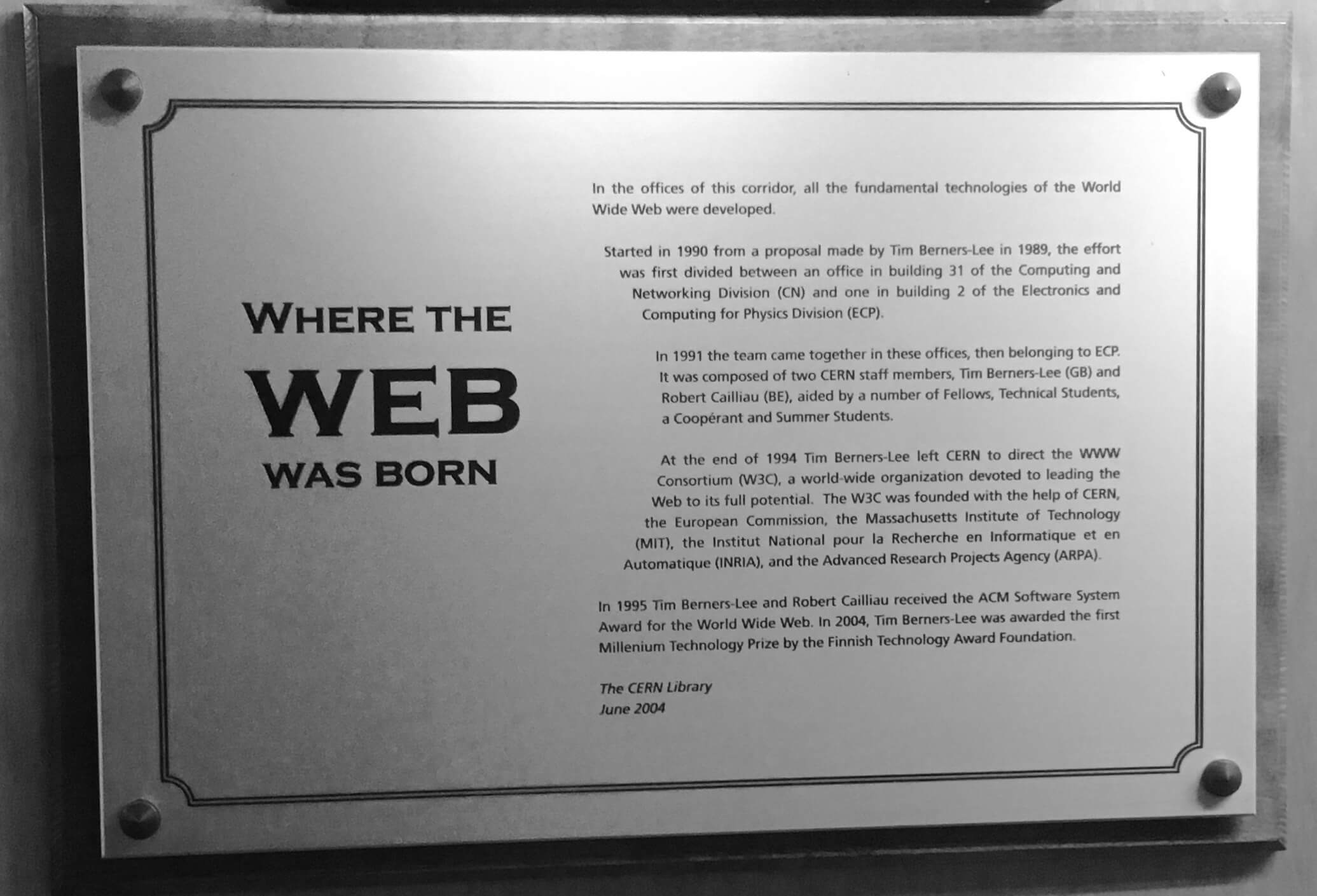
Inscription at CERN in front of the former office of Sir Tim Berners-Lee. Photographed during a visit in February 2019.
The Web for Scientists? - Does not yet exist!
In his initial proposal Tim Berners-Lee envisaged the Web as a tool to enable improved communication through "computer conferencing”. At CERN, the world’s largest particle physics laboratory near Geneva, Switzerland, the “Information Management system based on a distributed hypertext system” was intended to help improve the coordination and operation of the site’s complex research projects.
The Web, like the Internet, was rapidly adopted by academia, but they have yet to reach their true potential for science. This shortfall is firstly rooted in the strong inter-dependency between scholars, publishers and funders. Secondly the Web has lacked to this date ways that guarantee third-party, independent attribution, self-sovereign identity, and the ability for the transfer of value. Network effects consequently have made third parties such as publishers remain and even grow stronger in their influence given they could maintain to provide such services.
The latin inscription “non solus” (latin, “not alone”) of the dutch publisher Elsevier introduced in the 16th century remains even more true today: The requirement by funding agencies, especially since the 1960s to introduce objective performance metrics for scientific output has created a complex dependency among scholars, publishers and the public institutions that are funding most research.
Today this leads to a gridlock for collaboration and hampers scientific efforts to grow beyond small scaled structures. However problems of increasing complexity call for advanced technologies to allow coordination and scaling of scientific organising.
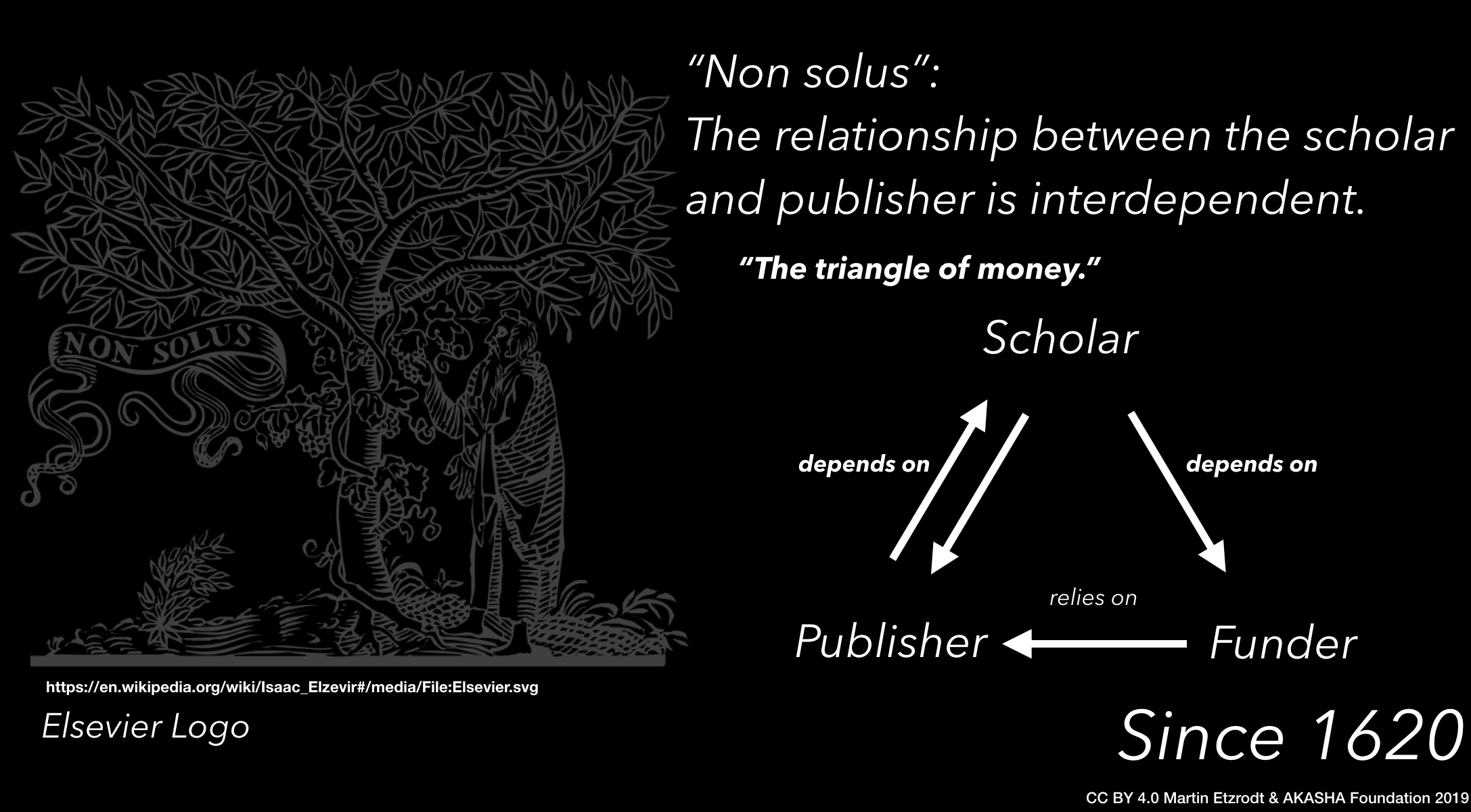
The triangle of money - and dependencies in science.
The emergence of “team science”
Notable exceptions to small scaled efforts in science are areas where funding constraints such as in astronomy, space exploration, and experimental physics “force” the scientific community to work closer together. It is unfortunate and surprising that we do not yet find massive, globally acting consortia that for instance aim to approach the search for cures of cancer in an open and collaborative way. There is not a single accepted reliable resource existing for cutting edge updates of research on specific types of cancer, for instance. Even if divergent in approaches and opinions, such common resources I believe could and should have already emerged on the Web.
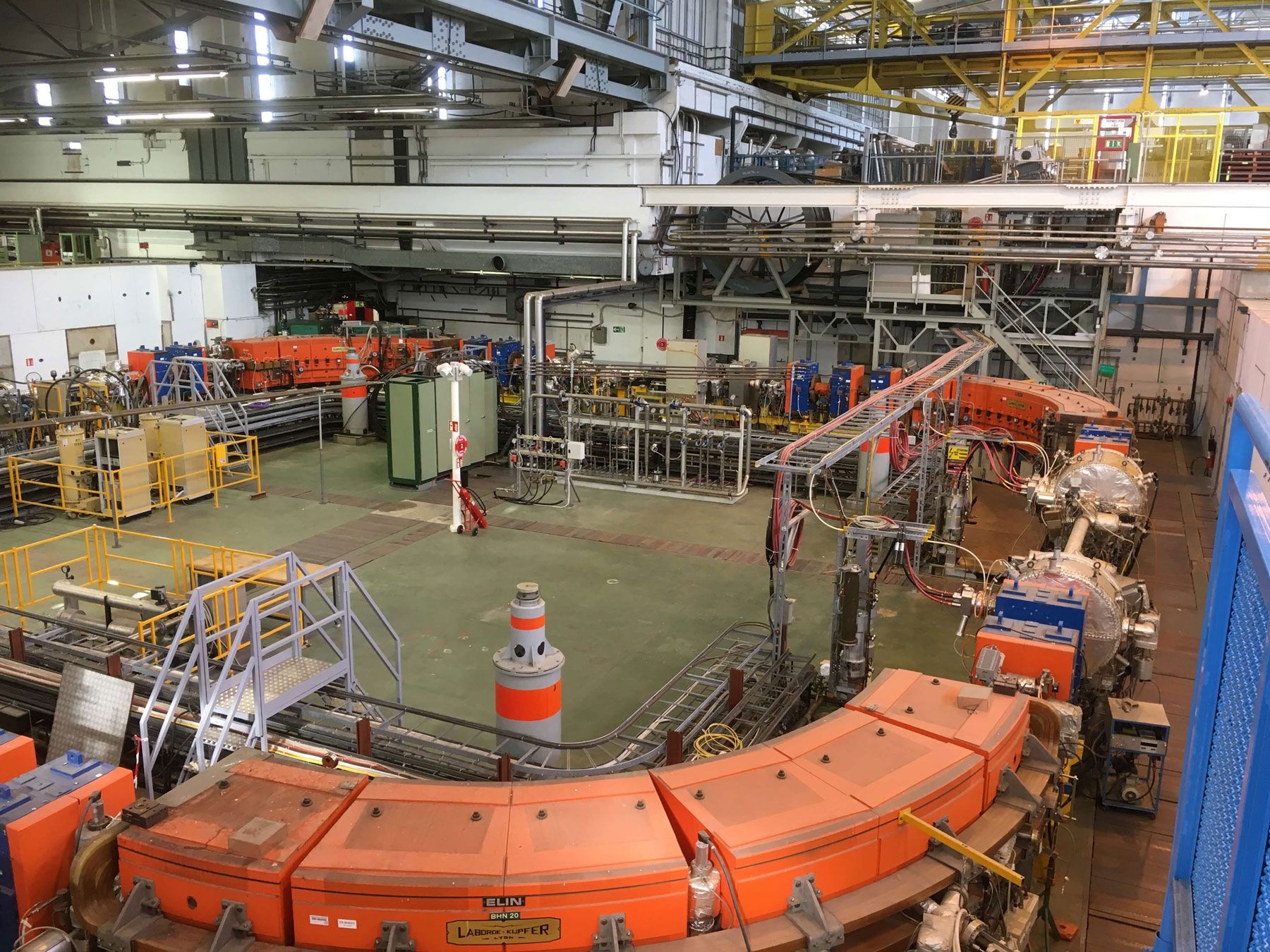
The former Low Energy Antiproton Ring at CERN. Experimental Physics is one of the fields in science that has a long tradition of collective collaborative scientific activities.
Instead we find that scientific fields remain “united in fragmentation” organizing their research efforts in mostly independent, small scale teams that risk to reinvent the wheel for the lack of an efficient and state-of the art means of coordination. In countless university hospitals around the world comparably small laboratories are tackling almost the same challenging problems but can share results only with delay and may sometimes even feel tempted to keep essential details on a method secret for exploitation on patents or to publish yet another paper. Notably a large industry of suppliers and service companies has evolved to tap into this publicly funded chaos and have little interest to change this situation. Thus, especially in the academic "kingdoms" still striving in European universities millions of Euros worth of redundant equipment catches dust.
I argue this is both an organizational as well as cultural phenomenon and persists because of the competition for original work demanded by journals, the funders’ requirement for provable impact and a wrong concept of "intellectual property". Further, especially early career scientists did not aim to produce papers, but to make discoveries that may change the world. Those that remain in the system have often forgotten the latter and are very proficient in the first.
Notable exceptions are the emergence of research institutes such as the Allen Institutes. Here team-science is celebrated and dedicated, collaborative teams are tackling specific, well defined problems in interdisciplinary teams. It is undoubtedly important to permit scientists to independently choose their area of research and allow also solitary and independent work. However I believe team-science will rapidly outpace many traditional laboratory setups that remain to operate in a haphazard fashion on hierarchical and feudalistic organisational paradigms.
In the future such team-science may be manageable through distributed organisations as described below enabling to harness a much larger number of minds contributing to a specific scientific challenge, thus permitting each individual to work on a problem he feels most suited to, independently of where she is located on the planet.
Blame for the current situation does not lie solely with the publishers, it is also the trained nature of the scientists' operational and cultural norms it selects for. I strongly advocate for a cultural as much as for a technological revolution. Crypto-networking technologies, as I will highlight in the next part, can do things the Web has been unable to do for us to date, allowing us to move beyond the traditional paper and also enabling new ways of attribution and thus collaboration and funding of science.
From “Denkkollektiv” (thought collective) to Collective Intelligence
Scientific data and knowledge are “anti-rival" goods, thus according to the definition of Lawrence Lessing and Steven Weber the “free dissemination increases their value and exceeds the profit gained by few through copyright or IP”. By imposing artificial limitations today scientific output is often turned into rival goods. Publishers do so in three ways: By restricting the amount of space granted for publication, by charging publishing fees, and restricting access through fees in many cases still. This locks out a large number of people from contributing and benefiting from the body of scientific knowledge created every day in our publicly-funded research institutes.
When scientists search for a solution to a long-standing question shouldn’t they be able to communicate their most recent breakthroughs in a direct and rapid fashion? Shouldn’t they be able to approach fellow scientists or be perhaps pointed to a matching collaboration partner that already found a solution that could advance their own efforts? I would argue that for several pressing challenges it is a moral necessity to share information and cooperate as effectively as possible.
The science theorist and physician Ludwig Fleck described in his seminal work “Entstehung und Entwicklung einer wissenschaftlichen Tatsache” (Genesis and development of a scientific fact) that scientific research is collective work, not a formal construct, but strongly dependent on the context within scientific communities. As such “thought collectives” change scientific ideas over time. Scientists need to be in constant communication, which was highlighted by Michael Polanyi in his 1962 essay “The Republic of Science”: “Activities of scientists are coordinated and rely on constant communication. Adjustment […] occurs in response to the results obtained by others.“
Today we define the ability of a group of people to extend their individual capabilities through cooperation and to reach a consensus on a certain task that can be more complex than the sum of the individual’s contributions as collective intelligence. The Web has greatly facilitated the emergence of such processes of collective intelligence as it in principle permits effective “ad-hoc” communication through computer networks in real time and at a global scale and at minimal cost. We are now able to organize ourselves much more rapidly and effectively and coordinate the contribution to an intellectual challenge from anywhere in the world.
As Manuel Castells points out “new information technologies are not simply tools to be applied, but processes to be developed”. 30 years after the Web’s creation we face both a crisis in the prevalent “social” Web as much as we do in the “Web for science”. To evolve towards the "pool of information to develop which could grow and evolve”, as proposed by Tim Berners-Lee, we need to introduce the technological improvements the distributed Web offers, such as the ability of creating decentralized identifiers (DIDs) and to prove ownership through cryptographic signatures.
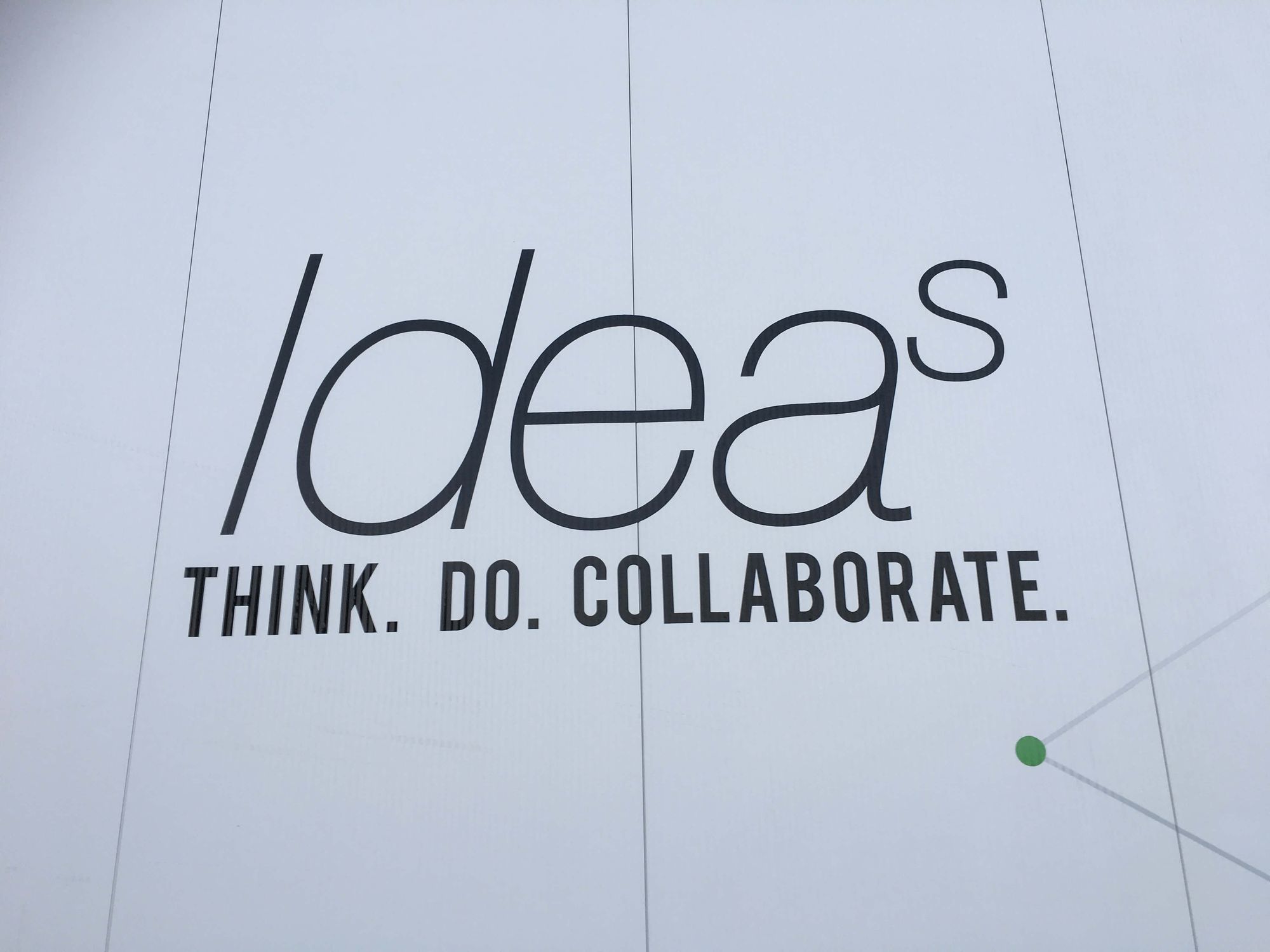
Motto of Idea Square at CERN.
Building the new home of science: Self-sovereign publishing
The recent advent of blockchain technology has solved first the double-spending problem, Bitcoin’s fundamental achievement. Now cryptocurrencies enable direct, peer-to-peer transactions. Notably, such “value” need not be monetary or “fungible” value. It’s not just banks as intermediaries that are threatened. This same technology allows us to “own” a cryptographically provable “address,” a form of proto-identity of ourselves on the Web that allows us to claim ownership and create transactions - also transactions of “knowledge.” This presents the birth of a self-sovereign and collective publishing medium.
Distributed ledger technologies and peer-to-peer file storage networks such as IPFS permit to create an immediate, permanent publication of any of our results and ensure direct attribution of the work. The stored data, timestamps and ID information is largely interoperable on the distributed Web, and we can create binding agreements that will execute as enforced in “smart contracts”, given previously defined conditions are met. This is largely reducing the administrative overhead and requirement for institutional intermediaries. It may be possible to create “peer-to-peer” fund allocations among individual scientists. We could for instance release a grant payment according to previously defined conditions or incentivise the creation of a prototype for which, following the proof of functional implementation funds are released.
In his work on the "Economy of Insight", the cyberneticist Paul Pangaro has formulated - “Conversations as Transactions”, that is “wealth creation has shifted from prior knowledge to the ability to gain knowledge-in-action.” Previously we needed competition to identify "the best" solution for a problem, while perhaps a combination of several other proposals would have created the optimal outcome for a given problem. "Knowledge" transactions now enable the emergence of distributed teams to work more effectively focusing on best solutions and not the "winning" one.
In 2017, Dr. Sebastian Bürgel at the Department of Biosystems Engineering of ETH Zurich and myself performed a proof of concept experiment in which we used some microscopy data I obtained and analysed in my laboratory. We broadcast them in IPFS and stored the created IPFS hashes of this work through an Ethereum blockchain transaction to obtain a timestamp and attribution.
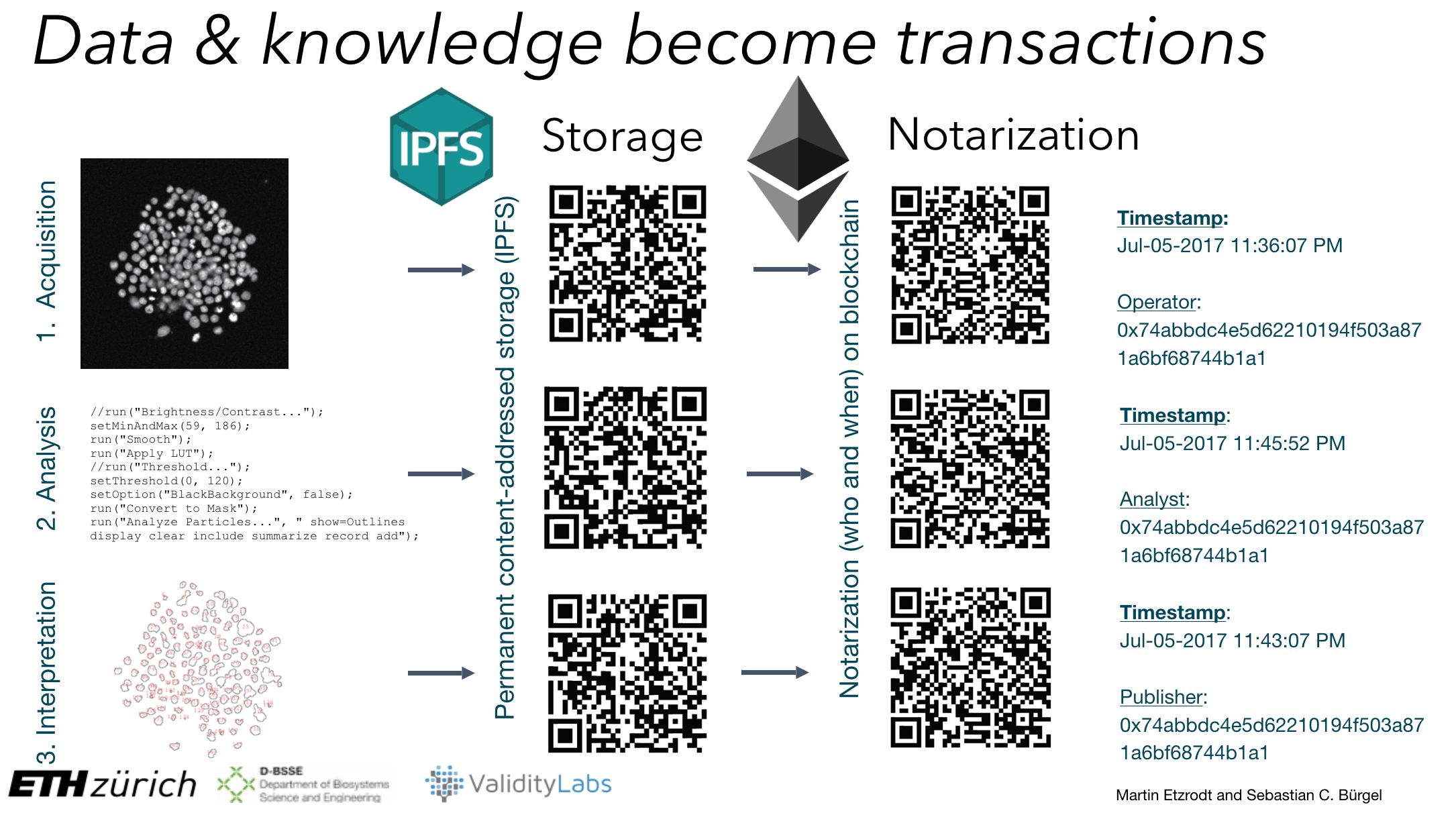
Raw data, Analysis scripts and interpretation of a scientific experiment can be made immutable, attributable and shareable.
A few months later I discovered that AKASHA has been using the very same components, Ethereum and IPFS, to create a much more advanced and elaborate self-sovereign, censorship-resistant “social media” publishing platform, since 2015. It is this fundamental new technology that I believe will revolutionise the entire 300+ years old approach of creating and sharing knowledge.
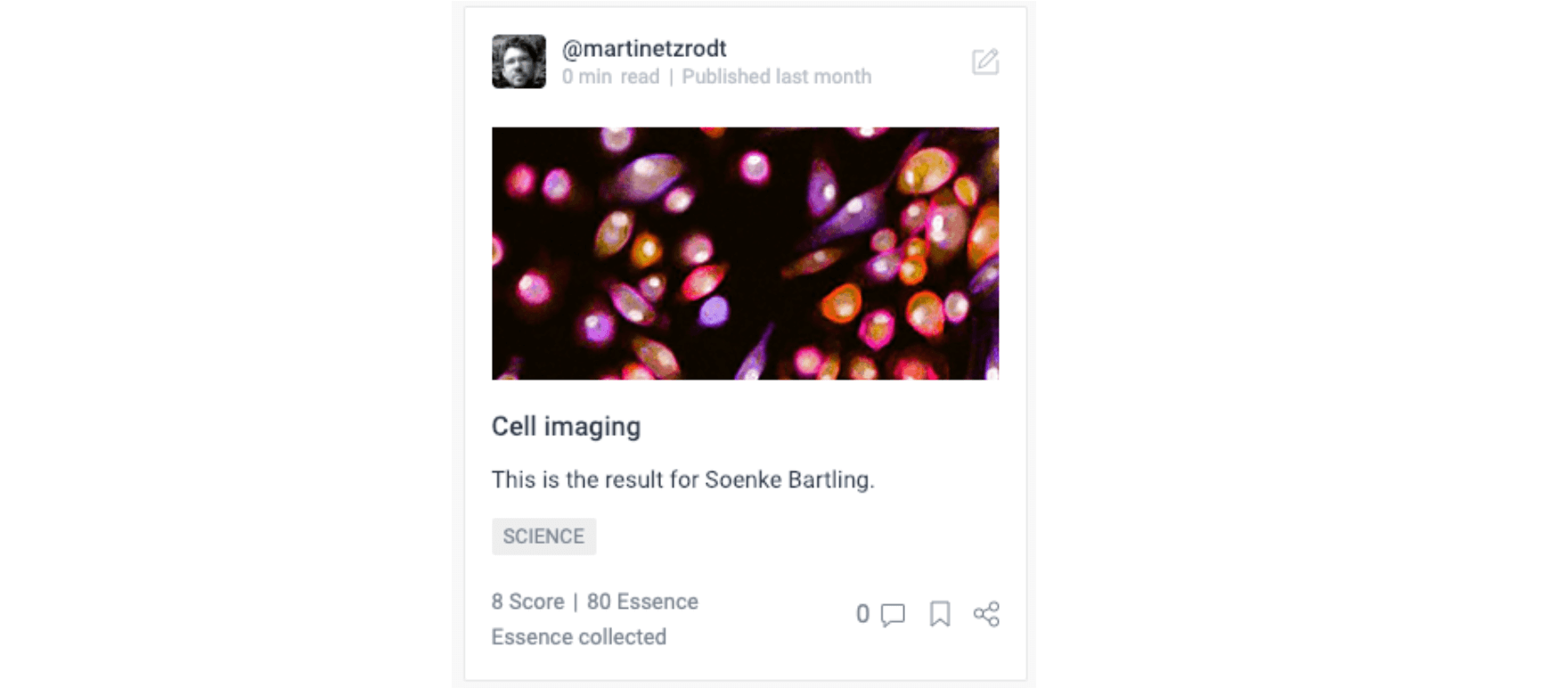
One of my first posts in the #SCIENCE section of AKASHA.
Self-sovereign publishing will enable what Polanyi proposed when he said that “The pursuit of science by independent, self-coordinated initiatives assures the most efficient possible organization of scientific progress.”
Scientific publishers and universities have coordinated these processes for some centuries, but we are now able to hand these authorities back to the individual scientists. This does not invalidate the operational status of a university, nor of a publisher. Both will likely be able to reform themselves, but it will change the way we interact with each other and the value they will deliver or the public can actually demand from them.
From journals to distributed autonomous organisations (DAOs), token curated registries (TCRs) & bonding curves
Distributed ledger technologies may be helping to democratise access to science and also making science funding, communication and translation more efficient. However to date it is not clear, which economic models currently explored may persist, many applications are only “games”. But this should not diminish their potential future impact, for “Play made the Modern World”.
In the early days ( 2016/17) “initial coin offerings” (ICOs) as means of crowdfunding research and peer-review of scientific projects have been proposed and implemented, for instance through the Mindfire Foundation or crowdfunding the sequencing of the Cannabis DNA.
We may need to understand science funding, communication and governance in a single complex though, through which very promising, new types organizations may be formed.
For instance, scientific journals are nothing else than curated lists of content. This is well known in a field of crypto-economics that aims to embrace content curation through so called token curated registries (TCRs) further reading.
Based on a universal “Open Access Datastream” through which all scientific data produced is accessible (proposed here and also by several authors in this living document) diligently curated list of new, field specific scientific content could easily be compiled and subscribed to, like the good old mailing lists did in the early days of the Web, or like RSS feeds. Good curators may gain large numbers of followers and reputation. Scientific associations, laboratories etc., could all publish their own curated lists that potentially overlap and are of different stringency and depending on their origin, trustworthiness. Given we can obtain additional metrics on each scientific work, such as the number of times is was accessed, downloaded, cited or even better reproduced, this could allow us to create increasingly reliable lists of state of the art knowledge in a specific field. Individuals could choose to compile their own set of filter or become subscribers and compare different outlets created from the common, open data stream.
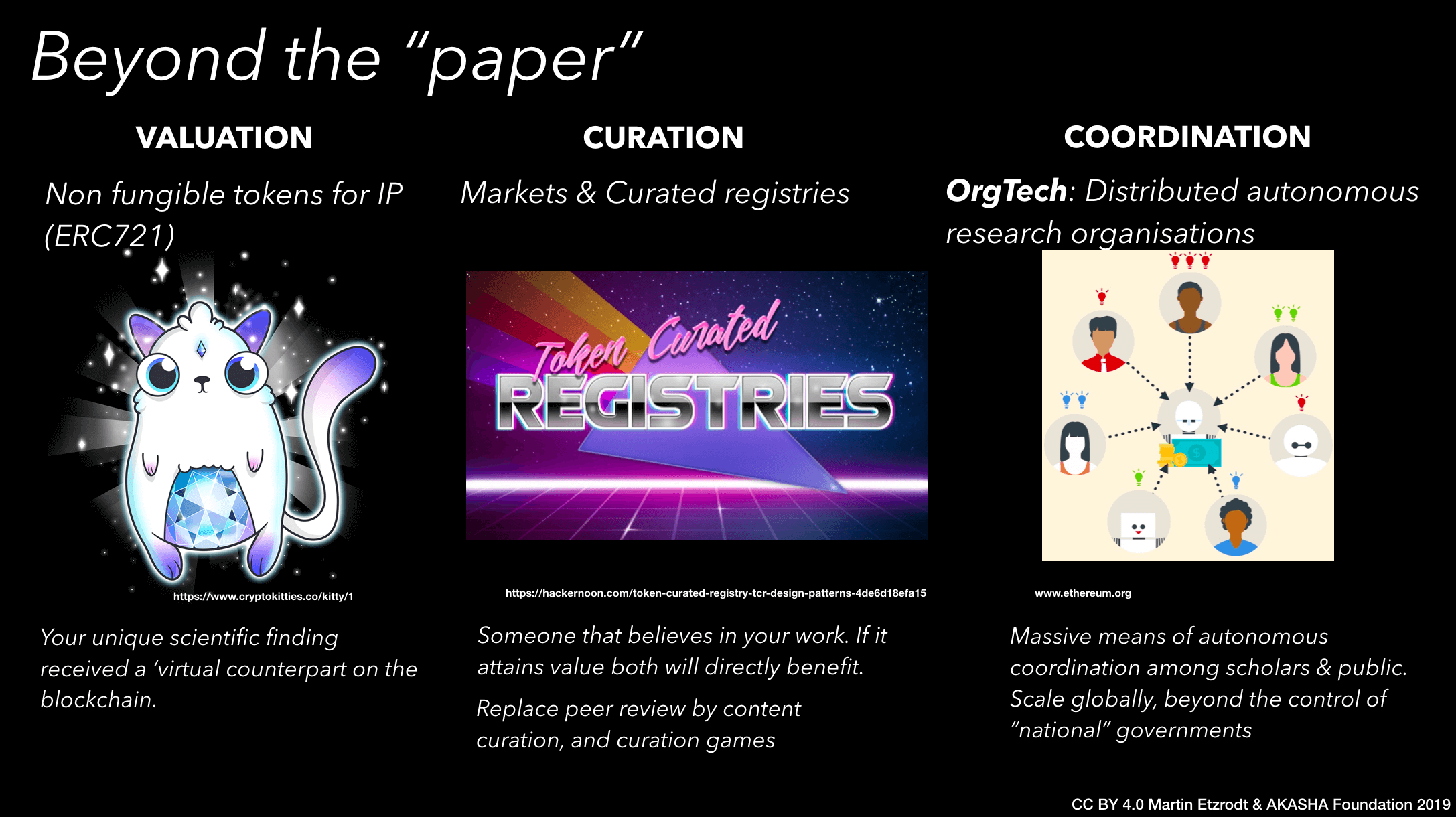
Let the crypto games for Science begin!
Platforms like AKASHA or Science Matters that provide a means for self-sovereign publication may be used to publish, add comments or add new or diverging results to the growing body of truly peer-to-peer created scientific knowledge. Any addition, even a small “micro-contribution” may be valuable for the discovery process. Such information is today often lost and both good ideas as well as reports on failed experiments are not communicated. While this sounds at first overwhelming Michael Nielsen points out several collaborative projects in his book "Reinventing Discovery" that already achieved with little effort and a classical Web 2.0 approach surprising results on collaborative research. One example being Timothy Gower’s Polymath blog that to this date remains to be a simple WordPress-based blog. Anyone can make a proposal for a mathematical problem in there and numerous such problems have been resolved to this date in a collaborative fashion.
Efficient new funding mechanisms, combined with a trusted communication system that allows new ways to attribute and curate content may ultimately form entirely new types of scientific organizations. Scientific distributed autonomous organisations (Science DAOs), proposed first by Soenke Bartling may emerge. These types of organisations will likely form around a specific scientific challenge and facilitate the coordination among scholars and the public. Private and governmental funders as well as individuals may invest in “Science DAOs” and foster the creation of massive research collaborations that can scale globally. These massive research organizations may not be operated by a single hierarchical administrative layer, but through a distributed network of financial and intellectual contributors.
Token curated registries and token bonding functions may be to date the most recent and promising tools to explore to organise and fund such new types of organizations, though much research remains to be undertaken here.
Conclusion
The introduction of self-sovereign and collaboration tools for science will largely remove third parties and hand more agency as well as responsibility back to the individual researcher. Aspiring scientists do not dream of simply writing papers when they begin their career, they dream of making world-changing discoveries and for this they should be rightfully recognised. On the other hand the increasing complexity of the scientific problems at hand call for improved cooperation. If implemented well, we may now be able to create new, globally-acting research organizations that can take on long-standing global challenges. We may also find that this will create a new generation of leaders in academia that embrace collaboration instead of mindless competition, are truly passionate not for their next “paper,” but are contributing to grow our knowledge by knowing how to “tame the fears of their ego” by sharing information and resources in a more rapid and comprehensive way that is required to accelerate the pace of innovation.
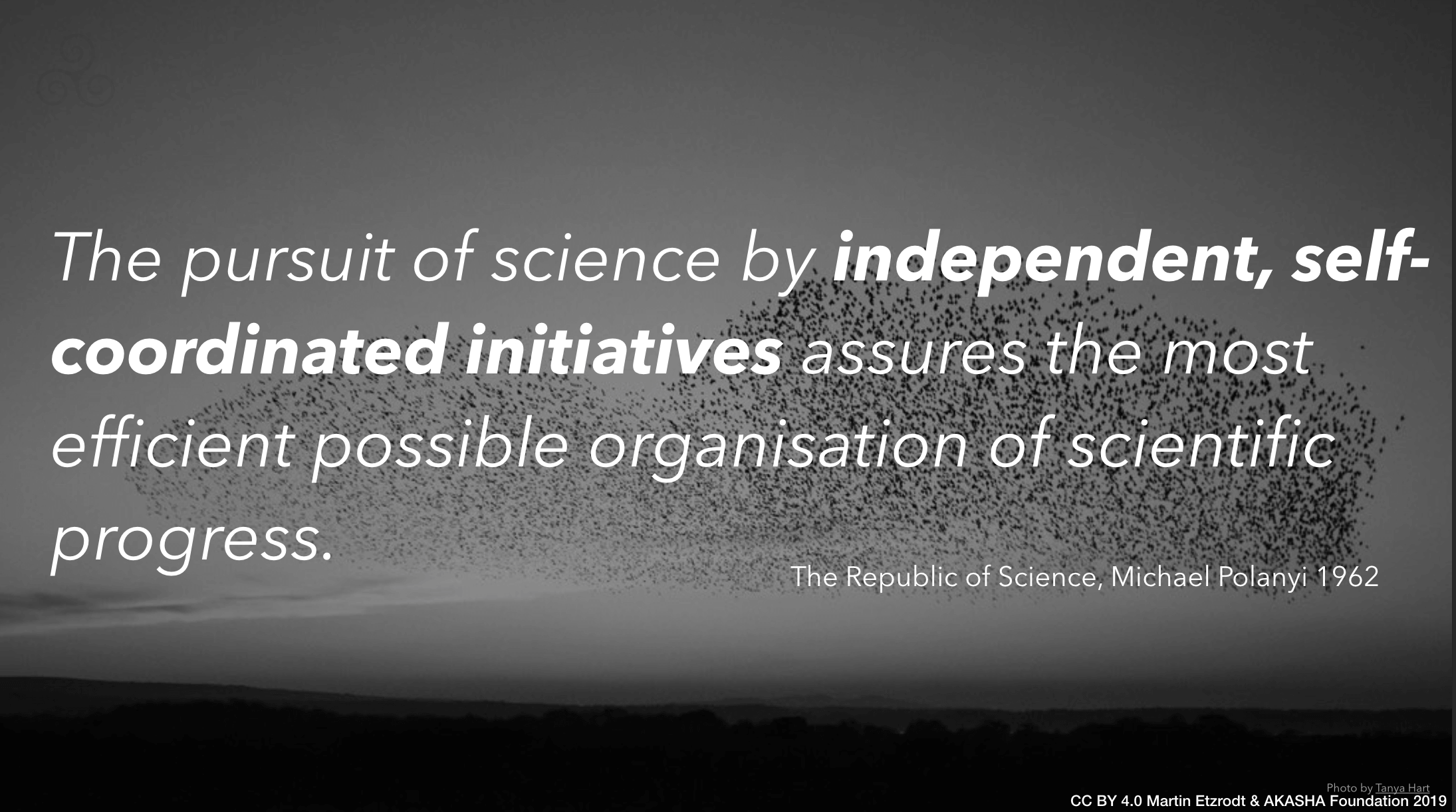
Acknowledgements: I would like to thank my colleague Philip Sheldrake for critical reading and helpful comments on this manuscript. The insights presented here have been incubated during numerous discussions within the AKASHA Foundation's research team. I also thank Soenke Bartling founder of the Blockchain for Science think tank, Lambert Heller from the TIB Open Science Lab, Prof. Stefan Krauss and Gotthold Fläschner for the continuous helpful discussions on the topic.
Cite as: Etzrodt, M. (2019). Distributed Organisations for Collaborative Research. AKASHA Foundation. 10.5281/zenodo.2581358

